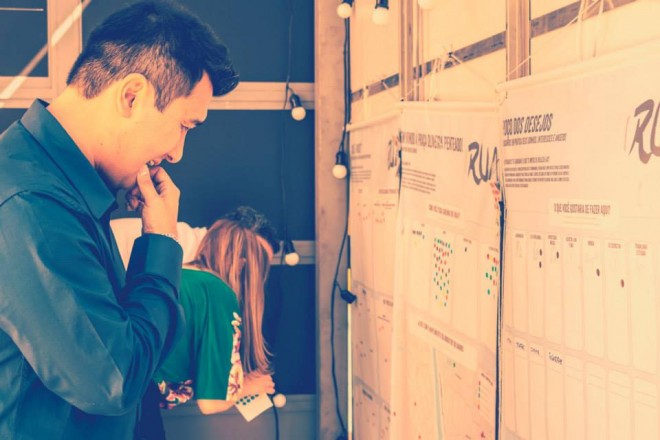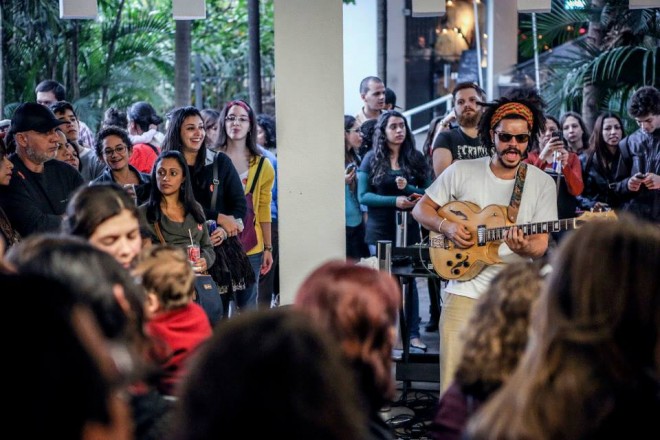A biweekly newsletter with public space news, resources, and opportunities.
A curated dispatch on all things public markets plus the latest announcements from the Market Cities Program.

Editor’s note: Every year PPS opens our doors to visiting students and professionals from around the world who are interested in collaborating with us on Placemaking projects and research. Currently, we are hosting two fellows from the Placemaking Leadership Council (PLC) in Brazil, which now boasts over 100 members. While here, these intrepid Placemakers have focused on gathering data and brainstorming ideas for the future of the PLC.
Jeniffer and Paola are out to change the world, one public space at a time. After years in the advertising and marketing sectors working for multinational corporations, Jeniffer and Paola both (separately) realized that they could do more for their communities and the public spaces within them. Following the path so many had before, their close study and appreciation of Jane Jacobs and William H. Whyte eventually led them to PPS, as they began thinking about how to effect positive urban interventions. With these goals in mind, they quit their day jobs and founded two organizations based on these principles in order to tackle the unique challenges facing São Paulo - eventually coming together to collaborate on Placemaking projects.
Alternating between the private sector and the advocacy world, they are committed to patching up problems and experimenting in Brazil’s urban environments. After a kick-off event for the Brazilian Placemaking Leadership Council with Fred Kent, Jeniffer and Paola took advantage of a cultural exchange grant through the Ministry of Culture in Brazil and promptly packed their bags for New York City. For the past three weeks, these zealous nuts have been regular fixtures in the PPS office, sharing their unique ideas and insights before heading home to run the Brazilian branch of the Placemaking Leadership Council.

Jeniffer Heeman | Bela Rua
In 2014, Jeniffer founded Bela Rua, an organization aimed at making a better urban life for people in São Paulo. Bela Rua created a method (or product, rather) that shows examples of how people can use a space differently and how people might positively react to new activities. This tool enables people to think differently about new ideas for future implementation.
“In 2010, my life changed when I was walking down a street in São Paulo. I asked myself why I loved that street but so many other streets didn’t feel that way, and if there's someone who could change the city into a better place for people. In that moment I decided that that person was going to be me.”
She commenced her first project in Oliveira Penteado Square, partnering with Odebrecht -- a construction company that had recently built a development nearby and simultaneously made physical improvements to the square. It became clear, however, that benches and trees alone were not enough to activate this space; people needed a reason to gather there and a more lively space would also help to deter unsafe or criminal activity.

The Cube came to life from a recycled construction container Odebrecht had used at its adjacent construction site. It could open on three sides to reveal a platform for live music events, and it provided secure storage for props such as additional seating, which could be used during storytime events. Then, when closed completely, it became a backdrop for movie screenings. It was Lighter, Quicker, Cheaper at its best.
These activations encouraged increased community input. Once people saw what this space could be, they began suggesting other ideas, inviting people to come to the events, and even setting up impromptu art exhibitions taking advantage of the newfound crowds. One section of the cube became a chalkboard on which they could express opinions (or simply doodle), and outreach events gathered suggestions on what the community would like to see next.

But even though the community loved the Cube project and the related public programming, now that the project is over, the liveliness of the square has diminished. The Cube project was an excellent way of showing better uses for the square, and for gathering information about what residents would like to see in that space, but Jeniffer’s ultimate goal is to create a more sustainable model in the future.

Paola Santiago | Conexão Cultural
Working for multinational corporations allowed Paola to see some pretty incredible places, and to experience some of the great public spaces within them. After being inspired by the vibrancy of several plazas in places like Paris and Barcelona, she began thinking about how she could translate this energy in her own city of São Paulo. After leaving the corporate world, she founded Conexão Cultural - a Brazilian organization (and B Corporation!) that connects people with art and culture in public spaces.
Her mission of a “creative occupation of public and cultural spaces” has taken shape in many ways, and, after meeting Jennifer of Bela Rua, Paola and her organization also played a key role in the the Cube project. When PPS’s Fred Kent came to São Paulo in 2014 for the first preliminary meeting of a Placemaking Leadership Council in Brazil, things began to fall into place.

PPS’s approach really resounded with Paola, and many of the principles we use every day were cleverly applied in their museum projects, specifically with the Museum of Image and Sound beginning in 2012. Originally the space felt unused, surrounded by cultural institutions with no real cultural character of its own. Inspired by the liveliness of the European squares she experienced, Paola set to work proposing activations such as music, food, public art, and workshops, in hopes of increasing visibility for local artists and enlivening the space.
“The key for the success was the great engagement from both parts - our team and the museum’s - and demonstrating that making the place welcoming, neighborly, attractive, connected, and charming, was increasing their public flow.”

Through more regular events (they’re now on their 7th season) thousands of people have benefited from turning a cultural space into a community place. While it was the museum’s genuine drive for improvement that was key to lasting change, replicating this model in other museums has not fared so well. Even when results are positive, budget issues and a resistance to change often pose the greatest challenges to successful events elsewhere.
Next steps
After returning to Brazil following their time here at PPS, Jeniffer and Paola are well aware of the unique challenges facing their home city. The top-down planning structure in São Paulo does not emphasize community process or collaboration with residents. The city lacks sufficient open green space, and the public spaces it does have are often barren or dangerous. Transportation, too, poses its own set of problems in a largely car-dominated city.
Nonetheless, change is happening, and the dedication and hard work of Jeniffer and Paola and their respective organizations is just a part of what is becoming a growing interest in Placemaking. Through the networking enabled by the Placemaking Leadership Council, it is sure to be a promising addition to the other urban activations happening in Brazil. The goal is that, through demonstration projects like these, Placemaking can become a central method and objective for public space design, and even for city governance.
At PPS, we’re thrilled to watch these two dedicated women spearhead the future of Placemaking in Brazil by working to break down silos and promote more interdisciplinary communication and networking. With over one hundred eager Placemakers waiting in São Paulo, planning for the next workshop is already underway, and we’re sure the future is bright for Brazil.
For more on the Brazilian Placemaking Leadership Council, you can visit their website or keep up with them on Facebook and Twitter.

The rich text element allows you to create and format headings, paragraphs, blockquotes, images, and video all in one place instead of having to add and format them individually. Just double-click and easily create content.
The rich text element allows you to create and format headings, paragraphs, blockquotes, images, and video all in one place instead of having to add and format them individually. Just double-click and easily create content.
Body Text Body Link
The rich text element allows you to create and format headings, paragraphs, blockquotes, images, and video all in one place instead of having to add and format them individually. Just double-click and easily create content.
Here is some highlighted text from the article.




Headings, paragraphs, blockquotes, figures, images, and figure captions can all be styled after a class is added to the rich text element using the "When inside of" nested selector system.
Headings, paragraphs, blockquotes, figures, images, and figure captions can all be styled after a class is added to the rich text element using the "When inside of" nested selector system.
Headings, paragraphs, blockquotes, figures, images, and figure captions can all be styled after a class is added to the rich text element using the "When inside of" nested selector system.